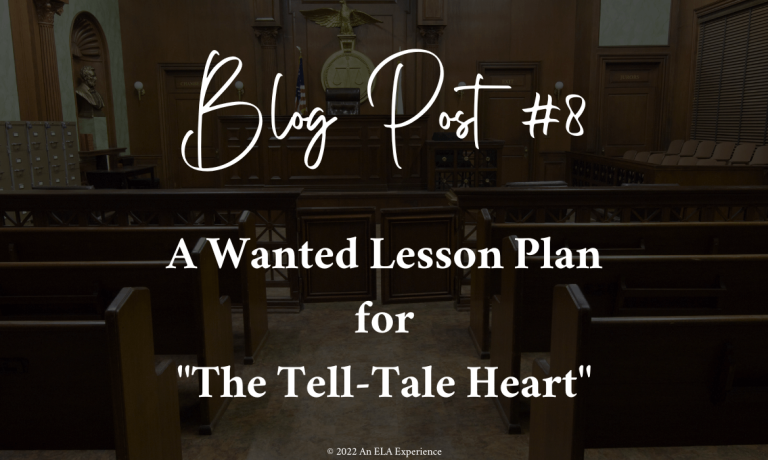My very first Halloween lesson plan for “The Tell-Tale Heart” consisted of a reading-writing connection where students read the short story and participated in writing roulette, an activity where each student begins a story and group members continue it. Instead of candy, I gave them sticky glow-in-the-dark eyeballs, which looked especially cool when you threw them onto desks but ended up on the ceilings of other teachers’ classrooms. Needless to say, as much fun as they were, I ditched the eyeballs. I also changed the lesson as teachers sometimes do after reflecting.
Both the story and writing roulette are engaging and I wanted to do something special for Halloween, but with all of the standards English teachers are required to cover, I wanted a lesson that not only engaged but hit the standards students needed to work on. That’s why I switched to a mock trial lesson with a short-answer question for assessment.

This lesson will cover everything from the hook to the closing activity, and as always, I’ll explain how to do this without you spending a penny, but if you’d like any of the handouts, visit Lesson Plan for “The Tell-Tale Heart” at my TPT store.
Before “The Tell-Tale Heart” Lesson
Begin by making copies, gathering costumes and props, and setting up your classroom. You don’t have to do everything I list. Do what you can; the students will still have fun with this lesson.
Copies
You’ll need copies of “The Tell-Tale Heart” that have room for annotations. Since this story is in the public domain, you can google and print it or visit commonlit.org. Just sign up for a free account to download the pdf.
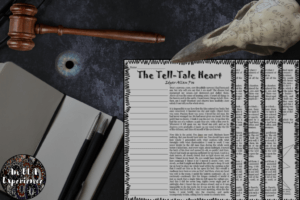
I also like to create nameplates for the students. I type the following roles in the middle of separate sheets of paper so they can be folded like a nameplate (nothing fancy).

- Prosecuting Attorney
- Criminal Defendant (the narrator from “The Tell-Tale Heart”)
- Criminal Attorney (the narrator’s attorney)
- Judge
- Courtroom Deputy Clerk
- Neighbor
- Police officer
- Jury and Jury Foreman
Costumes and Props
Purchase these, search your closets, or borrow them from your theater arts teacher.
- Reading glasses and/or notepads for the attorneys and members of the jury (The dollar store carries these.)
- Lantern for the narrator
- Judge’s robe (My college graduation gown was black, so I used it for the judge’s robe.)
- Gavel for the judge
- Badge or tie for the clerk
- Ears for the neighbor (I had some elf ears from an old costume; obviously, any ears will work.)
- Badges for the police officers (The dollar store has these in their toy section.)
Courtroom Setup
Set up classroom desks or tables to look like a courtroom with seats for the judge, prosecution, defense, and testifying witness.
Opening “The Tell-Tale Heart” Lesson
I must admit that it excites me to be the person to introduce students to Edgar Allan Poe. Whether it’s when seventh graders study “Annabel Lee” or eighth graders study “The Tell-Tale Heart,” I find that I have the pleasure of this introduction because the majority of students have only heard of him if even that.

My favorite way to introduce Poe is to gather students around me while I read a chapter on him from one of the following books. (I like both of these because they don’t read like an encyclopedia entry; instead, they give the interesting details, and they have pictures.)
How They Croaked: The Awful Ends of the Awfully Famous by Georgia Bragg and Kevin O’Malley
Lives of the Writers: Comedies, Tragedies (and What the Neighbors Thought) by Kathleen Krull
If you don’t have these books, don’t worry because your school librarian may have a copy and your local library surely will. If not, I still have you covered because you can show a few minutes of the Tragic Life of Edgar Allan Poe at Biography on YouTube or browse the Poe Museum.
The Meat of “The Tell-Tale Heart” Lesson Plan
Students will be reading the story twice. For the first reading, have them annotate each paragraph with main idea hashtags while listening to one of these dramatic readings by Gubler or Danielson.
- Matthew Gray Gubler from Criminal Minds (15 minutes) (I love Reid!)
- G. M. Danielson (20 minutes)
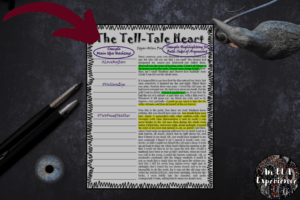
Stop every few paragraphs to share hashtags and check for understanding. In a nutshell, main idea hashtags sum up what the paragraph is about in a creative way with just a few words. (You’ll notice that students are familiar with hashtags, so they come up with some good ones.) For the first paragraph of “The Tell-Tale Heart,” I wrote #LoveMyEars since the narrator describes how incredible his hearing is.
Now, it’s time to choose the characters for the mock trial. Ask for volunteers to play the parts of the various characters from the story. (If you’re limited on time, consider leaving out some of the characters, like the judge, clerk, neighbor, and/or police officers.) Any student who doesn’t want to perform in front of the class can be a jury member.
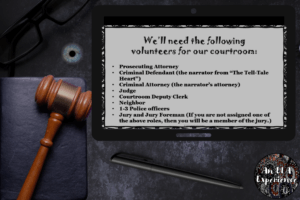
When first reading “The Tell-Tale Heart,” you know our narrator is mad and unreliable, but the students need to decide if he’s not guilty by reason of insanity according to the law. For this, because Virginia was the name of Poe’s wife and a place Poe spent much time in, I chose to refer to Virginia’s insanity law:
To be found not guilty by reason of insanity (NGRI), it must be determined that because of the impairment the defendant. . .
- could not distinguish right from wrong,
- did not understand the nature, character, and consequences of the act, or
- was unable to stop or control the behavior. (Usually, any premeditation invalidates this claim.)
Share this information with students. Then have them reread the story aloud or independently while highlighting or underlining evidence that supports the following:
- Their role in the trial,
- evidence that proves/supports the insanity defense, and
- evidence that disproves the insanity defense.

Students, especially the attorneys, will now need time to prepare. Allow them to work with partners or small groups to write statements to use during the trial:
- Opening statements (if you have time)
- Witnesses to be called and questions to ask them
- Closing statements (if you have time)
- What they will say if called to the stand to testify

Begin the mock trial, allowing students to use their notes as needed.
When all evidence has been presented, ask the jury to agree on a verdict and the judge to sentence the narrator accordingly.
Assessing “The Tell-Tale Heart” Lesson
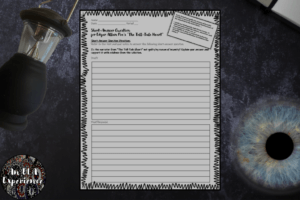
One way to assess students is with a short-answer question. I like these because I limit them to ten lines (unless they’re dying to write more, which they sometimes are), they’re easy to grade, they require textual evidence for support, and they help them learn about writing and developing body paragraphs.
For this lesson, I use “Is the narrator from “The Tell-Tale Heart” not guilty by reason of insanity? Explain your answer and support it with evidence from the selection.” (You could also ask questions about theme, suspense, literary elements, and more.)
I share this simplified rubric with students. In my classroom, students earned a 100 for writing a 3, a 90 for a 2, a 70 for a 1, and a 60 for a 0.
3–Insightful response that is thoroughly explained and supported with pertinent textual evidence
2–Sufficient response that is explained and supported with relevant textual evidence
1–Correct answer but limited explanation (no textual evidence and/or evidence does not support the response)
0–The answer is incorrect.
I also remind them to use APE to guide their responses (A = Answer, P = Proof, and E = Explanation). Students do not have to answer the question in this order, but I find that sharing this mnemonic with them helps them remember what to include when answering a short-answer question.
Closing “The Tell-Tale Heart” Lesson
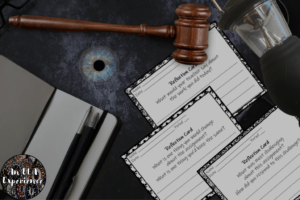
Close the lesson by asking students to reflect on the lesson and/or their learning with questions such as these:
- What was most challenging about this assignment? How did you respond to this challenge?
- What would your teacher say about the work you did today?
- What is one thing you would change about the assignment? What is one thing you’d keep the same?
That’s it! If your students complete every task I’ve written about, then this lesson will take about four forty-five-minute periods. However, you can shorten that considerably by hosting a debate instead of a trial, reading the story only once, and/or omitting the Poe introduction, the assessment, or the reflection.
Related Links for “The Tell-Tale Heart”
My Resources for “The Tell-Tale Heart” on TPT
Eleven Scary Stories of Gothic in Literature for High School English
“The Tell-Tale Heart” Lesson Plans, Summary, and Analysis
Now, if you’re interested in having students edit their short-answer question (or any writing), visit my ninth blog:
“Teaching Students to Edit a Little Every Day.”
Happy Halloween to you and your students! I hope every one of you enjoys this lesson plan for “The Tell-Tale Heart!”

